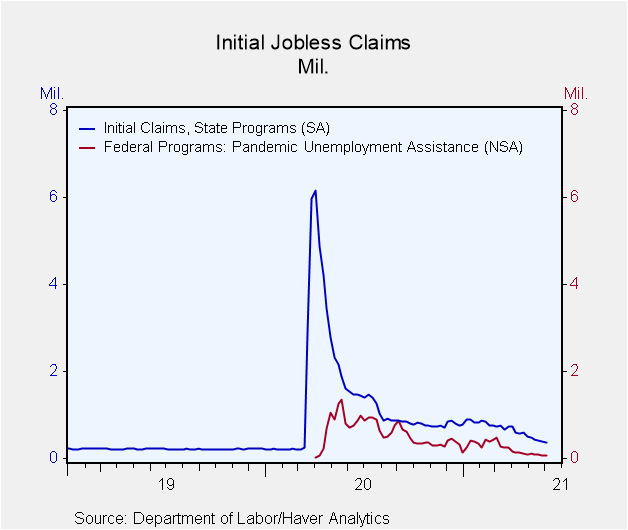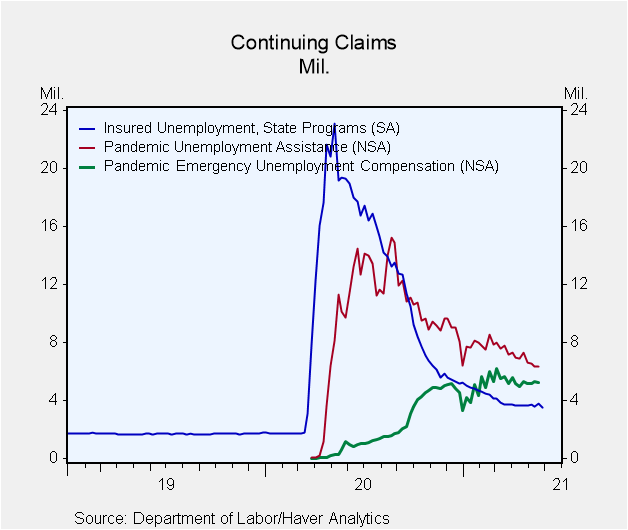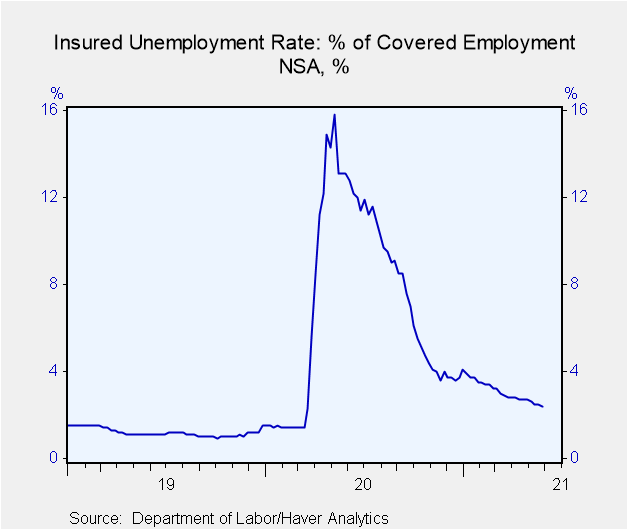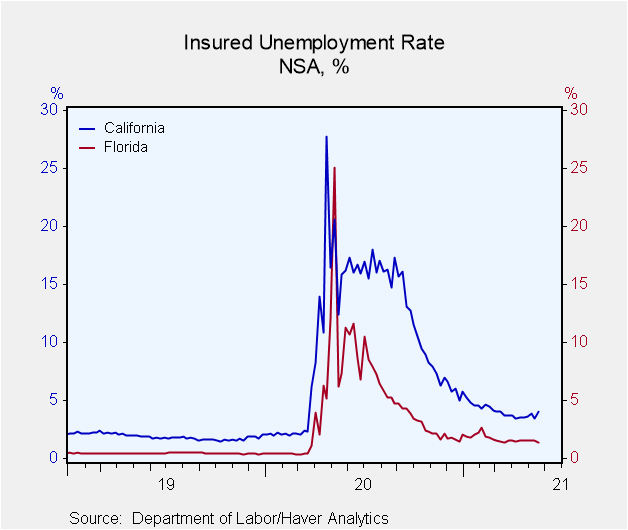 Global| Jun 10 2021
Global| Jun 10 2021U.S. Unemployment Insurance Claims Continued Their Decline
by:Sandy Batten
|in:Economy in Brief
Summary
• Initial state claims down another 9,000. • Continuing state claims fall to pandemic low. • PUA claims lowest since very first week of program in April 2020. Initial claims for unemployment insurance fell 9,000 in the week ended June [...]
• Initial state claims down another 9,000.
• Continuing state claims fall to pandemic low.
• PUA claims lowest since very first week of program in April 2020.
Initial claims for unemployment insurance fell 9,000 in the week ended June 5 to 376,000 from an unrevised 385,000 in the previous week. The Action Economics Forecast Survey panel expected 375,000 new claims in the latest week. These regular state-program claims are now approaching the pre-pandemic "normal" range of 200,000-300,000 that had prevailed in periods of economic expansion prior to the pandemic. The latest claims figure is the lowest since 256,000 in the week of March 14, 2020. The 4-week moving average fell to 402,500 in the week ended June 5, also a pandemic low, from 428,000 in the previous week.
Initial claims for the federal Pandemic Unemployment Assistance (PUA) program fell to 71,292 in the week ended June 5 from a downwardly revised 73,249 in the previous week (initially 76,098). The most recent figure is the lowest since April 4, 2020, the first week of the program, in which 32,078 initial claims were filed. The PUA program provides benefits to individuals who are not eligible for regular state unemployment insurance benefits, such as the self-employed. Given the brief history of this program, these and other COVID-related series are not seasonally adjusted.
Continuing claims for regular state unemployment insurance fell 258,000 in the week ended May 29 to 3.499 million, also a pandemic low. The resulting state insured rate of unemployment declined 0.2%-point to 2.5%, again a pandemic low. This rate reached a high of 15.9% in the week of May 9, 2020, while the average rate in 2018 and 2019 was 1.2%.
Continuing PUA claims were 6.347 million in the week ended May 22, down from 6.306 million the prior week. Continuing PEUC claims edged down 69,869 in that week to 5.232 million. The Pandemic Emergency Unemployment Compensation (PEUC) program covers people who have exhausted their state unemployment insurance benefits.
The total number of all state, federal, and PUA and PEUC continuing claims was 15.349 million in the May 22 week, down 95,099 from the previous week. This was the lowest reading since just after the pandemic-related programs began in early April 2020. This grand total is not seasonally adjusted.
The state insured rates of unemployment in regular programs continued to vary widely. In the week ending May 22, the highest insured unemployment rates were in Nevada (4.77%), Rhode Island (4.50%), Connecticut (4.17%), California (4.05%), Alaska (3.88%) and Pennsylvania (3.85%). The lowest rates were in South Dakota (0.53%), Alabama (0.73%), Kansas (0.74%), Utah (0.77%) and Nebraska (0.79%). Insured unemployment rates in other large states included New York (3.69%), Illinois (3.61%), Texas (1.72%) and Florida (1.35%). These state rates are not seasonally adjusted.
Data on weekly unemployment claims going back to 1967 are contained in Haver's WEEKLY database, and they are summarized monthly in USECON. Data for individual states are in REGIONW. The expectations figure is from the Action Economics Forecast Survey, carried in the AS1REPNA database.
| Unemployment Insurance (SA, 000s) | 06/05/21 | 05/29/21 | 05/22/21 | Y/Y % | 2020 | 2019 | 2018 |
|---|---|---|---|---|---|---|---|
| Initial Claims | 376 | 385 | 405 | -75.5 | 1,352 | 218 | 220 |
| Initial Claims (NSA) | 367 | 425 | 419 | -76.4 | 1,353 | 218 | 221 |
| Initial Claims Pandemic Unemployment Assistance (NSA) | 71 | 73 | 81 | -89.8 | -- | -- | -- |
| Continuing Claims | -- | 3,499 | 3,757 | -81.9 | 10,380 | 1,699 | 1,754 |
| Continuing Claims (NSA) | -- | 3,316 | 3,490 | -82.7 | 10,370 | 1,704 | 1,763 |
| Continuing Claims Pandemic Unemployment Assistance (NSA) | -- | -- | 6,347 | -- | -- | -- | -- |
| Insured Unemployment Rate (%) | -- | 2.5 | 2.7 |
12.2 |
7.1 | 1.2 | 1.2 |
Sandy Batten
AuthorMore in Author Profile »Sandy Batten has more than 30 years of experience analyzing industrial economies and financial markets and a wide range of experience across the financial services sector, government, and academia. Before joining Haver Analytics, Sandy was a Vice President and Senior Economist at Citibank; Senior Credit Market Analyst at CDC Investment Management, Managing Director at Bear Stearns, and Executive Director at JPMorgan. In 2008, Sandy was named the most accurate US forecaster by the National Association for Business Economics. He is a member of the New York Forecasters Club, NABE, and the American Economic Association. Prior to his time in the financial services sector, Sandy was a Research Officer at the Federal Reserve Bank of St. Louis, Senior Staff Economist on the President’s Council of Economic Advisors, Deputy Assistant Secretary for Economic Policy at the US Treasury, and Economist at the International Monetary Fund. Sandy has taught economics at St. Louis University, Denison University, and Muskingun College. He has published numerous peer-reviewed articles in a wide range of academic publications. He has a B.A. in economics from the University of Richmond and a M.A. and Ph.D. in economics from The Ohio State University.










